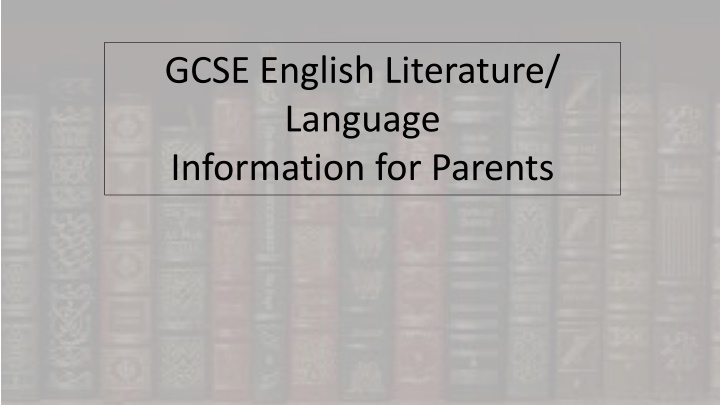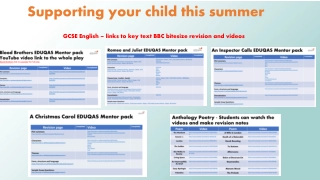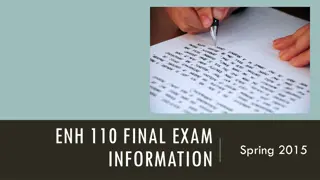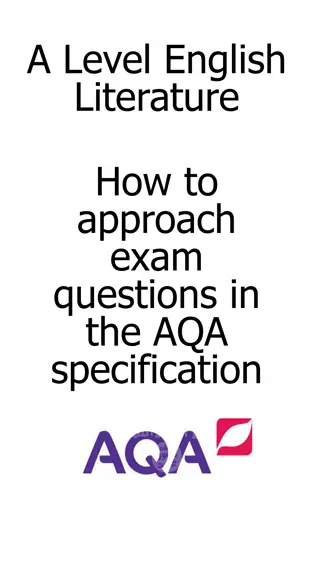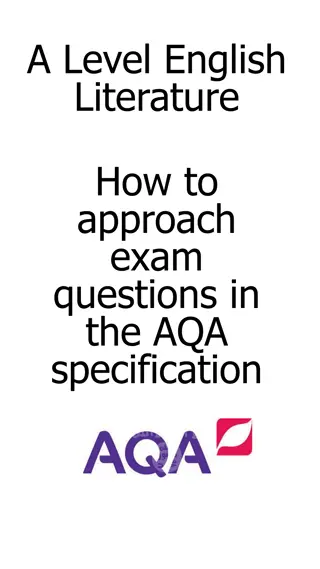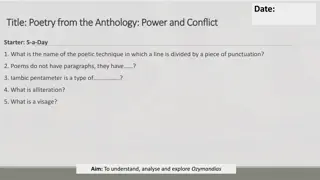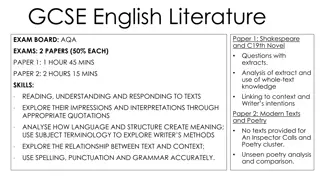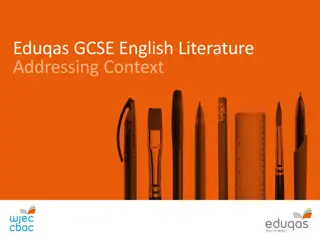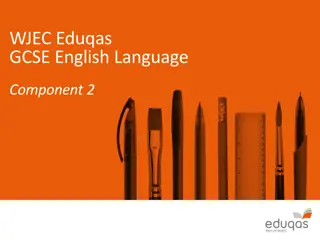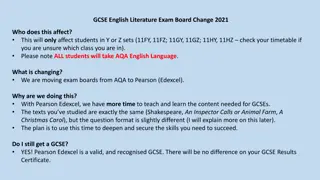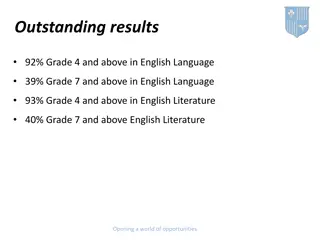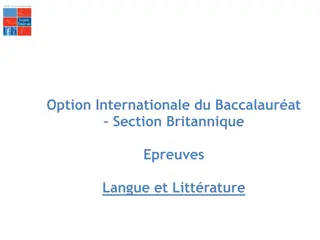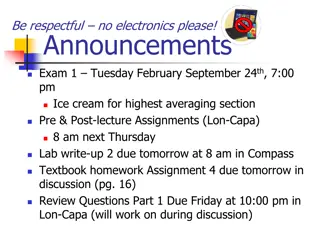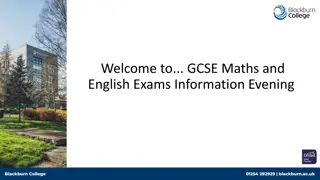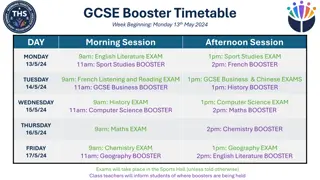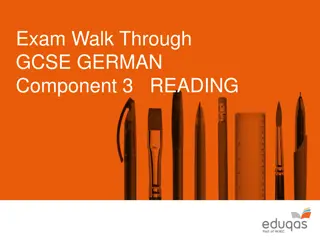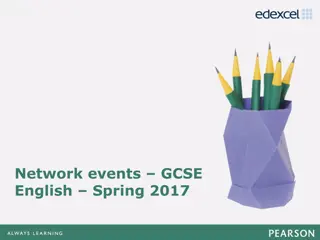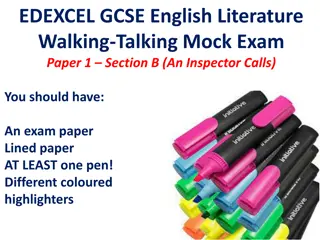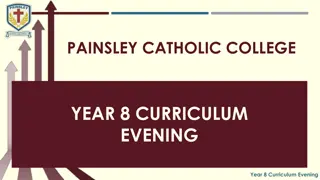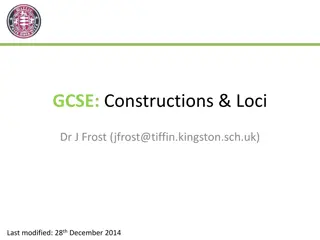Approaching GCSE English Literature Exam Questions
GCSE English Literature exams consist of Paper 1 on Shakespeare and 19th-century prose, and Paper 2 on modern plays and poetry. The assessment objectives include reading, analyzing language, understanding contexts, and using vocabulary effectively. Students can approach questions by linking extracts to the whole text, focusing on key words, methods, and quotations. Two approaches are suggested: linking extract to the whole text and analyzing the extract first before exploring the whole text in detail.
Download Presentation

Please find below an Image/Link to download the presentation.
The content on the website is provided AS IS for your information and personal use only. It may not be sold, licensed, or shared on other websites without obtaining consent from the author.If you encounter any issues during the download, it is possible that the publisher has removed the file from their server.
You are allowed to download the files provided on this website for personal or commercial use, subject to the condition that they are used lawfully. All files are the property of their respective owners.
The content on the website is provided AS IS for your information and personal use only. It may not be sold, licensed, or shared on other websites without obtaining consent from the author.
E N D
Presentation Transcript
GCSE English Literature/ Language Information for Parents
GCSE English Literature For this year the papers will be Paper 1 Shakespeare and 19th century prose 17th May 1 hour 45mins Section A: Shakespeare Macbeth 30 marks + 4 for SPAG (extract provided) Section B: Dr Jekyll and Mr Hyde OR A Christmas Carol 30 marks For both questions, an extract is provided and students have to make references to elsewhere/ know quotations) Paper 2 Modern Play and Poetry 24th May 2 hours 15 mins Section A: A choice of 2 questions on: An Inspector Calls or Blood Brothers . Closed text, no extract. 30 marks + SPaG 4 marks Section B: Poetry Anthology Power and Conflict poems. One question, one poem given and students choose another to compare. 30 marks Section C: Unseen poetry analysis 24 marks Comparison with second poem 8 marks
GCSE English Literature AOs The Assessment Objectives are the same for each paper but may be weighted differently. . A01: Read, understand and respond to texts whole text, task and quotations A02: Analyse the language, form and structure (methods) used by writers to create effects, using appropriate subject terminology A03: Show understanding of the relationships between texts and the social/ historical contexts in which they were written. A04: use a range of vocabulary and sentence structures for clarity, purpose and effect, with accurate spelling and punctuation (only 4 marks for both questions on P 2)
There are two possible ways to approach this question. Approaching the question. In each paragraph aim to include: Approach A: Linking extract to whole text throughout 1. Highlight key words in the question. Method/ AO2 The writer uses Method used - linked to language, imagery or dramatic devices 2. Annotate the passage for ideas/ methods/quotes to explore. Q Quotation or even better 3. Identify links to elsewhere in the text could be similar ideas/ methods or contrasting to show change. EQ Embedded quotation (integrated in a sentence) 4. Write a paragraph on the extract followed by a linked paragraph on the whole text. Effect An effect of the quote/ word level analysis 5. Go back to the extract again and aim to do this 3 times. AO1 links Links to ideas in another part of the text Approach B: Extract first, then whole text 1. Highlight key words in the question. AO3 Link to context e.g. ideas linked to kingship, the suoernatural, women 2. Annotate the passage for ideas/ methods/ quotes. So/ therefore/ thus So sentence reflecting on the effect on the audience 3. Cover at least 2 paragraphs based on ideas/ methods in the extract. Dev comment Ideas developed in detail - go one step further. 4. Cover at least 2 paragraphs based on ideas/ methods elsewhere in the play.
Our approach to the extract questions Questions likely to be about character or theme Students will be given an extract from each text to start them off In this extract from Act 1 King Duncan is receiving news regarding the battle against the Norwegians MALCOLM This is the sergeant Who like a good and hardy soldier fought 'Gainst my captivity. Hail, brave friend! Say to the king the knowledge of the broil As thou didst leave it. Sergeant Doubtful it stood; As two spent swimmers, that do cling together And choke their art. The merciless Macdonwald-- Worthy to be a rebel, for to that The multiplying villanies of nature Do swarm upon him--from the western isles Of kerns and gallowglasses is supplied; And fortune, on his damned quarrel smiling, Show'd like a rebel's whore: but all's too weak: For brave Macbeth--well he deserves that name-- Disdaining fortune, with his brandish'd steel, Which smoked with bloody execution, Like valour's minion carved out his passage Till he faced the slave; Which ne'er shook hands, nor bade farewell to him, Till he unseam'd him from the nave to the chaps, And fix'd his head upon our battlements. DUNCAN O valiant cousin! worthy gentleman! Question: Starting with this extract how does Shakespeare present Macbeth as both a hero and a villain in the play? Section A Paper 1: Macbeth 30 marks plus 4 on offer for SPaG 55 minutes(5 mins for proofreading) Our approach to the extract question: Read through all of the information given and the text and aim to pinpoint where in the play the extract is from Start to highlight and annotate the extract based on the AOs Begin to make links between other parts of the play (jotting down relevant quotations from memory) Plan 3 well developed paragraphs to answer the question using EXTRACT, WHOLE, WHOLE structure We also teach them to follow a formula for each paragraph them to hit all of the individual criteria subject terminology; recognising the writers methods; using quotations; exploring the effect of individual words; considering the effects on the audience/ reader and making links to the context.
Literature Paper 1 Section B: Jekyll and Hyde OR A Christmas Carol Dr. Jekyll & Mr Hyde Or A Christmas Carol 30 marks 50 minutes For example: Starting with this extract, how does Stevenson create a sense of horror within Jekyll and Hyde ? as he lay and tossed in the gross darkness of the night and the curtained room, Mr. Enfield's tale went by before his mind in a scroll of lighted pictures. He would be aware of the great field of lamps of a nocturnal city; then of the figure of a man walking swiftly; then of a child running from the doctor's; and then these met, and that human Juggernaut trod the child down and passed on regardless of her screams. Or else he would see a room in a rich house, where his friend lay asleep, dreaming and smiling at his dreams; and then the door of that room would be opened, the curtains of the bed plucked apart, the sleeper recalled, and lo! there would stand by his side a figure to whom power was given, and even at that dead hour, he must rise and do its bidding. The figure in these two phases haunted the lawyer all night; and if at any time he dozed over, it was but to see it glide more stealthily through sleeping houses, or move the more swiftly and still the more swiftly, even to dizziness, through wider labyrinths of lamplighted city, and at every street- corner crush a child and leave her screaming. And still the figure had no face by which he might know it; even in his dreams, it had no face, or one that baffled him and melted before his eyes; Our approach to the extract question: Read through all of the information given and the text and aim to pinpoint where in the novel the extract is from Start to highlight and annotate the extract based on the AOs Begin to make links between other parts of the story (jotting down relevant quotations from memory) Plan 4-6 paragraphs to answer the question using EXTRACT, WHOLE, EXTRACT, WHOLE structure We also teach them to follow the same formula for each paragraph
Literature Paper 2 :An Inspector Calls J.B Priestley or Blood Brothers Willy Russell 45 mins 30 marks + SPaG 4 marks One question from a choice of two (character / theme based) Image result for eva smith Our approach to this question: Students need to be confident with the playwright s ideas, themes, characters and devices used They will need to know key quotations and be confident with citing evidence from across the text, both through speech and stage directions. They should plan 3-5 key moments / methods used within the play to explore that relate to the question they select They will be taught a formula for each paragraph that ensures they hit the mark scheme
Literature Paper 2 : Section B Poetry Anthology (prepared poetry from Power and Conflict section of the anthology) 45mins 30 marks One question. One poem given. Students will choose a second poem to compare with the first depending on the question and the named poem. Our approach to this question: Students need to be confident with at least 6 poems from across a variety of themes: identity, power, war, nature, places, conflict. They will need to know key quotations and be confident with citing evidence from across a range of poems and exploring the methods used by poets They will need to know the background about each poem, too. They must remember it is a comparison and so should focus on using comparative words throughout each paragraph. They will be taught a formula for each paragraph that ensures they hit the mark scheme
Literature Paper 2: Section C Unseen Poetry 45mins (2 questions) Advice to a Teenage Daughter Nettles My son aged three fell in the nettle bed. 'Bed' seemed a curious name for those green spears, That regiment of spite behind the shed: It was no place for rest. With sobs and tears The boy came seeking comfort and I saw White blisters beaded on his tender skin. We soothed him till his pain was not so raw. At last he offered us a watery grin, And then I took my billhook, honed the blade And went outside and slashed in fury with it Till not a nettle in that fierce parade Stood upright any more. And then I lit A funeral pyre to burn the fallen dead, But in two weeks the busy sun and rain Had called up tall recruits behind the shed: My son would often feel sharp wounds again. Vernon Scannell Unseen Poetry SPAG 4 marks) a) 24 marks 30 minutes b) 18 marks 15 minutes (plus You have found a new war-game called Love. Here on your dressing-table stand arrayed brave ranks of lipsticks brandishing swords of cherry pink and flame. Behold the miniature armies of little jars packed with the scented dynamite of flowers. See the dreaded tweezers; tiny pots of manufactured moonlight, stick-on stars. Beware my sweet; conquest may seem easy but you can t compete with football, motor cycles, cars, cricket, computer-games, or a plate of chips. Two unseen poems For the unseen poetry students need to have the independent skills and confidence to annotate an unseen poem in relation to ideas, structure and language devices. Our approach: Annotate poems based on AO1 and AO2 Look for wider themes and ideas Cover 3 main points / paragraphs For comparison use Both, however a) In Nettles how does the poet present ideas linked to a parent wanting to protect a child? 24 marks By Isobel Thrilling b) What is similar or different in the methods poets use to convey ideas in Nettles and Advice to a Teenage Daughter ? 8 marks
GCSE English Literature What your child can do to revise Practise annotation of extracts; Trace development of main characters and themes in a text through a visual plan/ poster; Research background and context, reading others responses to the text; Write plans and paragraphs based on essay questions, rather than the full answer; Create mind maps and text maps, revision posters on plot, themes, characters, methods, quotations, historical/ social context; Learn quotations with a partner Quote-offs on social media have worked well Open the texts at random, with a partner summarise what happens just before and just after this point in the text; Timed exam practice questions using passages provided but also selecting your own passages and writing questions; Get a partner to give a key theme from the text and see if you can speak about it for a minute without stopping;
GCSE English Literature Ideas for how you can support your child Encourage frequent testing of quotations (copied and put somewhere prominent around the house) Talk about the texts and ask about themes/ characters/ context. Watch film versions together and talk about how the text compares/ what is different? (Be aware merely watching films and understanding the plot of texts gives a basic level of understanding. It is knowledge of the actual language and structural devices in the text itself examiners will be rewarding). Ensure their own copies of the text are re-read/ skim read and annotated Re-read sections together and discuss Test them on their revision cards on characters, themes, methods, context Look at some unseen poems and discuss ideas and features they can spot
GCSE English Literature Resources and revision material Class notes and PowerPoints Copies of the text annotated Audio versions of texts Bitesize Genius website CGP books/ snap revision guides Revision booklets with extracts provided by the department You Tube Mr Bruff/ Mr Sales in particular Spark notes Cliffsnotes No fear Shakespeare
AQA English Language 2 Papers: 160 marks total 50% reading 50% writing ( they need to be hitting roughly half marks across the questions 2-5 for a 4, above this the grades are more concentrated ) 2019 Grade boundaries: 127 9, 117 8, 113 7, 98 6, 86 5, 76 4, 56 3, 36 2, 16 1 Key Messages Read the sources - annotate Follow the formula for the reading questions and know the skills rewarded on the mark scheme Plan and develop writing sufficiently Practise writing under pressure
Key Messages Know the approach - prepare and practise complete full responses to get out of the habit of giving up half way through Vocabulary experience it and use it Use the writing booklet, build up vocabulary banks, lists of words linked to expressing viewpoint Work smart under timed conditions (as in the exam) when it gets closer Methods key term we use referring to language and structural devices they need to identify these and use in their own writing Be a critical reader think about the writer s intentions and the viewpoint the bigger picture Confidence with literacy skills and developing extended writing
Reading Reading AO1: AO1: Reading AO3 Compare writers texts and ideas (also links to context for Literature) Identify and interpret explicit and implicit information; Select and synthesise evidence from different texts Evaluate texts critically and support this with appropriate textual references Reading AO4 THE ASSESSMENT OBJECTIVES Writing AO6 Writing AO5: use a range of vocabulary and sentence structures, with accurate spelling and punctuation Communicate clearly and imaginatively Organise ideas
Questions will be phrased in a similar line to the this: Questions will be phrased in a similar line to the this: Read specified lines in the Source. List four things from this part of the source may quote directly, use own words or paraphrase. Needs to include subject and be a clear statement. The WHAT? Q1 AO1 Skills: a retrieval task: find specific information relating directly to the questions and the lines specified. Do not process information. Students 2.5% 5 mins 4 marks The HOW? Q2 AO2 Lang Read the specified lines in the Source. How does the writer s use of language Selecting best use of language (words/ phrases, LFs, sentence forms); state the LF; quote; analyse the effect on the reader. Comment on how the use of language shapes your response. It is the quality of the analysis of language which moves students up the mark scheme. 5% 15 mins 8 marks The HOW? Q3 AO2 Structure Whole of the Source. How has the writer structured the text to interest you as a reader? Skills: beginning and ending; shifts in focus; widening or narrowing of focus; repeated motif; short para/sentence for specific dramatic; changing perspectives; changing focuses. 5% 15 mins 8 marks The WHY? Q4 AO4 Evaluate A statement will be made. The question will start: To what extent do you agree ? Consider the how (methods) and the why (writer s intentions). Needs a sense of critical detachment. Expressing an opinion evidenced through references to the text. Analyses the effects of the writer s methods ( lang or structural devices). Include a range of relevant quotations and justify opinions. Interrogate the text and ask questions leading from the what to the how to the why. Students can agree/ challenge the statement or do a bit of both. Use of topic sentences and connectives to build a structured argument across paragraphs beneficial e.g. Furthermore, Conversely, On reflection. 12.5% 25 mins 20 marks Q5 AO5 & 6 Writing Either: Write a description/narrative suggested by this picture. Or: Describe/narrate PLAN for structure and effect. Communicate clearly; organise information; LFs to suit purpose; range of vocabulary; range of sentence forms; accurate spelling and punctuation. There will always be a colour image linking to the reading source. Use the reading source for ideas if need be e.g. structural effects, complex vocabulary. Proof read for your 5 easy ways and make changes. Quality not quantity. 25% 45 minutes 40 marks
Questions will be phrased in a similar line to the this: Questions will be phrased in a similar line to the this: The WHAT ? Q1 AO1 True and False statements. Choose four statements which are true. Skills: a retrieval task: find specific information relating directly to the questions and the lines specified. Some inference for understanding may be required. 2.5% Up to 5 mins 4 marks The WHAT ? Q2 AO1 Use details from both sources to write a summary of the differences or similarities. Select, synthesise and make inferences. Will be based on a specific focus in the texts. Marks are for the quality of summary and inference not for the number of points selected. PEI and Link x 2 needed. Higher level responses will move more fluently between the two texts to synthesise and will give perceptive inferences. 5% Up to 15 mins 8 marks The HOW? Q3 AO2 Structure Refer to Source B read specified lines. How does the writer s use of language ? Skills: analysis of language; selection of a well-judged range of quotations; use subject terminology appropriately. PEA (analysis rather than explain for higher students, exploring effects and how these link to the writer s intentions). 7.5% 15-20 mins 12 marks The WHY? Q4 AO4 Evaluate Refer to the whole of both Sources. Compare how the writers have conveyed Focus here is on comparing the writer s views/ perspectives and how these are conveyed through methods. Methods could include: structural features, sentence types and language features. Could be a focus on similarities or differences. 10% 20 -25 mins 16 marks Q5 AO5 & 6 Writing Question will specify the format e.g. letter, speech, article. No choice. A statement will be given then the student writes in the form for the purpose and audience to express their point of view. EG: Write an article to your local newspaper in which you argue for or against this statement. Communicate clearly; organise information; LFs to suit purpose; range of vocabulary; range of sentence forms; accurate spelling and punctuation. Use the magic list to generate ideas e.g. global, historical, personal, cultural perspectives. Use connectives (furthermore, in addition) to signpost progression of argument. Proof read for 5 easy ways and check evidence of form, audience and purpose. 25% 40 -45 minutes 40 marks
Paragraph sequence for language e.g. The writer employs an extended metaphor of power and strength to describe the Tyrannosaurus Rex. He says it towered over the trees, the verb towered suggesting that the huge creature is imposing itself on its jungle surroundings from a great height, and intimidating everything beneath it. It is personified as a great evil god , implying the Tyrannosaurus Rex is an all-powerful being without mercy, and also a terrible warrior , an image that conveys to the reader the idea of an invincible fighting machine destroying everything in its wake.
Working towards success Complete writing little and often. Use sample papers and spend time crafting higher level responses at this stage, using more time if needed. Closer to the exam test yourself by working under tighter time constraints. Get feedback from your teachers. Know what you need to focus on for each of the reading questions and strategies you can use for using time efficiently (e.g. annotating for q2 and 4 on Paper 2 at the same time) Use YouTube tutorials for a fresh look at each question. Plan descriptive writing you could perhaps use in the actual exam description linked to the weather, a persona you could write from the perspective of. Read editorial articles expressing viewpoints to become familiar with the style and practise writing opinion pieces yourself. Use revision materials provided e.g. the writing booklet, breakdown of reading questions, past papers and mark schemes, sample answers in your books Be Proactive - Know the questions you need to practise questions 4 and 5 carry the most marks. Can you move up a few marks on past papers? How will you address your areas of weakness? You need to actually write responses to get better not just watch videos/ attend revision sessions. Address literacy skills use the literacy booklets to build confidence with punctuation and word classes. Learn key spellings. Learn and use vocabulary.
